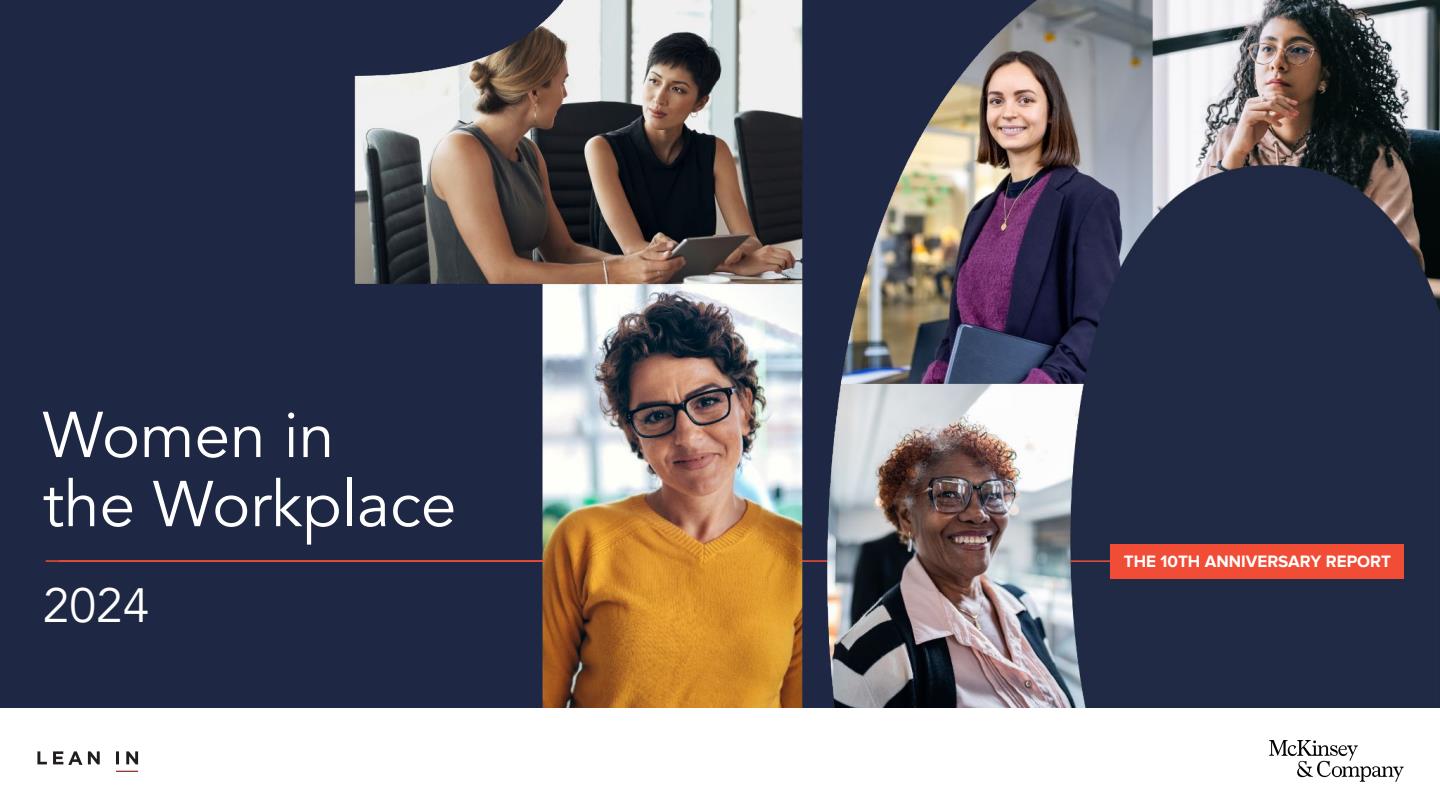This year marks the tenth anniversary of the Women in the Workplace report. Conducted in partnership with LeanIn.Org, this effort is the largest study of women in corporate America. Over the past decade, more than 1,000 companies have participated in the study, and we have surveyed more than 480,000 people about their workplace experiences.
For this year’s report, we collected information from 281 participating organizations that collectively employ more than ten million people. At these organizations, we surveyed more than 15,000 employees and more than 280 HR leaders, who shared insights on their policies and practices. The report provides an intersectional look at the specific biases and barriers faced by Asian, Black, Latina, and LGBTQ+ women, as well as women with disabilities.
Our tenth-anniversary report analyzes data from the past decade to better understand progress, decline, and stagnation in women’s representation and experiences in the workplace.1 It also highlights key findings from 2024 and identifies the changes companies can make to chart real progress on the path to parity—which we project is nearly 50 years away. Over the past decade, women have made important gains at every level of the corporate pipeline (especially in senior leadership). Yet progress is surprisingly fragile, especially for women of color,2 who continue to be underrepresented at every level and who view gender and race as obstacles to their advancement. In many instances, we also see that women’s outlook and day-to-day experiences are not much different, or are even worse, than they were nearly a decade ago.
As we reflect on the results from this year, and from the past ten, three things are true. First, companies took action that has led to important progress. Second, change is hard and messy, and we’re somewhere in the middle of the shifts needed to fix the pipeline and make the culture of work more equitable. Third, the gains made are more fragile and less extensive than they appear. Taken together, the scorecard for corporate America is mixed—and though there are bright spots that suggest many companies have momentum, we also see that company commitment to diversity is declining. As we look ahead to the next ten years, the path forward for corporate America is simple: keep going. Over the past decade, women have remained ambitious and committed to their jobs. Now, we need companies to stay ambitious and committed to the important work they have started.
The rest of this article summarizes the main findings from the Women in the Workplace 2024 report.
The corporate pipeline: Progress is not parity
Over the past decade, women’s representation has increased at every level of corporate management (Exhibit 1). Most notably, women today make up 29 percent of C-suite positions, compared with just 17 percent in 2015. But progress has been much slower earlier in the pipeline, at the entry and manager levels.3

Image description:
Six area charts show the percentage of women employed in various corporate roles from 2015 to 2024. Women’s representation at the entry level rose from 45% in 2015 to 48% in 2024, while in manager roles it rose from 37% to 39% over the same period. Women’s representation in senior manager/director roles rose from 32% in 2015 to 37% in 2024, while in vice president roles it grew from 27% to 34% over the same time period. Women’s representation in senior vice president roles increased from 23% in 2015 to 29% in 2024, while in C-suite roles it rose from 17% to 29% over the same time period. The data show that while women’s representation in corporate roles has increased over the past decade, gains have been modest, with representation declining as women advance through the corporate hierarchy.
Source: Women in the Workplace 2024, McKinsey & Company and LeanIn.Org
End of image description.
However, the corporate pipeline is not as healthy as the numbers suggest. Women remain underrepresented across the pipeline, a gender gap that persists regardless of race and ethnicity (Exhibit 2). Simply put, men outnumber women at every level.

Image description:
A segmented bar chart shows the percentage of men and women in various corporate roles. At the entry level, 48% of employees are women, including 28% White women and 19% women of color, while White men represent 33%. At the manager level, 39% of employees are women, including 27% White women and 13% women of color, while White men represent 41%. At the senior vice president level, 28% are women, while 58% are White men. At the C-suite, 29% of employees are women, including 22% White women and 7% women of color, while White men represent 56%. The data indicate a trend of declining representation of women in more senior roles, regardless of race and ethnicity.
Note: Figures may not sum to 100%, because of rounding. Total percent of women per level may not sum to overall corporate pipeline totals, because overall figures do not include employees with unreported race data.
Source: Women in the Workplace 2024, McKinsey & Company and LeanIn.Org
End of image description.
What’s more, women continue to face barriers at the beginning of the pipeline. They remain less likely than men to be hired into entry-level roles, which leaves them underrepresented from the start. Then, women are far less likely than men to attain their very first promotion to a manager role—a situation that’s not improving (Exhibit 3). In 2018, for every 100 men who received their first promotion to manager in 2018, 79 women were promoted; this year, just 81 women were. Because of this “broken rung” in the corporate ladder, men significantly outnumber women at the manager level, making it incredibly difficult for companies to support sustained progress at more senior levels. This phenomenon is even worse for women of color, who represent only 7 percent of current C-suite positions—just a four-percentage-point increase since 2017.

Image description:
A bar chart shows the number of women promoted to manager for every 100 men promoted to manager from 2018 to 2024. The chart shows women’s promotions have remained relatively stagnant, rising from 79 in 2018 to 81 in 2024 for every 100 men promoted, peaking at 87 in 2022 and 2023.
Source: Women in the Workplace 2024, McKinsey & Company and LeanIn.OrgEnd of image description.

Image description:
A bar chart shows the number of White women promoted to manager for every 100 men promoted to manager from 2018 to 2024, compared to the average number for women of all races who were promoted. In 2018, 84 White women were promoted for every 100 men promoted. This dropped to 80 in 2019, rose to 89 in 2020 and 2021, peaked at 94 in 2022, then declined to 91 in 2023 and 89 in 2024. The number of White women promoted to manager outperformed against women overall.
Source: Women in the Workplace 2024, McKinsey & Company and LeanIn.Org
End of image description.

Image description:
A bar chart shows the number of Asian women promoted to manager for every 100 men promoted to manager from 2018 to 2024, compared to the average number of women of all races who were promoted. In 2018, 80 Asian women were promoted for every 100 men promoted. This rose to 83 in 2019, 98 in 2020, and peaked at 116 in 2021. The number dropped to 95 in 2022, 89 in 2023, and slightly increased to 99 in 2024, but still remained below the 2021 number. The number of Asian women promoted to manager outperformed against women overall.
Source: Women in the Workplace 2024, McKinsey & Company and LeanIn.Org
End of image description.

Image description:
A bar chart shows the number of Black women promoted to manager for every 100 men promoted to manager from 2018 to 2024, compared to the average number of women of all races who were promoted. In 2018, 60 Black women were promoted for every 100 men promoted. This dropped to 58 in 2019 and 2020, rose to 82 in 2021 and 96 in 2022, and declined to 54 in 2023, remaining at 54 in 2024. With the exception of 2022, the number of Black women promoted to manager underperformed against women overall.
Source: Women in the Workplace 2024, McKinsey & Company and LeanIn.Org.
End of image description.

Image description:
A bar chart shows the number of Latinas promoted to manager for every 100 men promoted to manager from 2018 to 2024, compared to the average number of women of all races who were promoted. In 2018, 81 Latinas were promoted for every 100 men promoted. This dropped to 68 in 2019, rose to 71 in 2020 and 86 in 2021, then declined again to 75 in 2022, 76 in 2023, and 65 in 2024. With the exception of 2018 and 2021, the number of Latinas promoted to manager underperformed against women overall.
Source: Women in the Workplace 2024, McKinsey & Company and LeanIn.Org
End of image description.
Women have made modest but meaningful gains at the vice president and senior-vice-president levels since 2018, but their progress is more fragile than it appears. The main driver of women’s increased representation was a reduction in the number of line roles (that is, positions with profit-and-loss responsibility, a focus on the company’s core operations, or both), which disproportionately affected men given that they hold more of these positions. In the C-suite, women’s progress was even less sustainable. While the reduction of line roles was still a factor, the primary reason women’s representation increased was because companies, on average, added staff roles—that is, positions in support functions, such as human resources, legal, and IT—and hired women into these new positions. Since companies cannot add new staff roles indefinitely, this is not a viable path to parity.
At the current pace of progress, it would take 22 years for White women to reach parity4—and it would take more than twice as long for women of color (Exhibit 4). Put another way, it would take 48 years for the representation of White women and women of color in senior leadership to reflect their share of the US population; this is true parity for all women. To achieve this, companies will need to maintain their current rate of progress, which means addressing weak spots in their pipelines: by finally fixing the broken rung, investing more resources in developing women leaders, and holding themselves accountable for more substantive progress in senior-leadership roles.

Image description:
A chart features a blue line representing a 50-year time frame, from 2020 to 2070, showing projections for achieving gender parity for all women in senior vice president and C-suite roles.
Parity for White women is projected to be achieved by 2046, 22 years from 2024. Parity for women of color is projected to take 48 years to achieve, arriving in 2072.
Footnote: Parity is defined as the representation of all women in senior vice president and C-suite roles based on workforce representation trends in the US Census, the current representation of women in entry-level roles, and the assumption that the pipeline and growing population of diverse women will attribute to greater representation of women at senior levels in future. This is 25% of total representation each for White women and women of color, respectively.
Source: Women in the Workplace 2024, McKinsey & Company and LeanIn.Org
End of image description.
Company actions: There is still critical work to do
Over the past decade, companies have taken steps to support the advancement of women and make the workplace more equitable. And employees recognize this: a majority think women have more opportunities to advance and point to companies’ increased efforts to make the workplace more equitable.
One point of progress is that today, almost all surveyed companies provide critical support for employees who are parents, caregivers, or managing health challenges—benefits that link to higher rates of happiness and employee retention. Benefits such as these are especially helpful to women, who are more likely than men to have caregiving responsibilities.
Workplace flexibility is another benefit that has expanded significantly in the past decade. Mostly in response to the pandemic, companies dramatically increased their hybrid and remote-work options. Eight in ten employees say flexibility has improved over the past ten years, and employees consistently point to greater productivity and reduced burnout as primary benefits. Flexibility is especially important to women, who report having more focused time to work when working remotely.
To view last year’s report, please visit Women in the Workplace 2023. For previous reports, please visit the archive.
Companies are also doing more to debias hiring practices and performance reviews but need to go further. When we look at five core practices for debiasing—developing clear evaluation criteria for hiring, before candidates are considered; offering bias training for hiring evaluators; aspiring to have diverse slates of similarly qualified candidates for open positions; developing clear evaluation criteria for performance reviews; and sending reminders to avoid bias during reviews—just one in four surveyed companies have adopted all of them. And the companies that have implemented the full array of practices tend to make the greatest strides in advancing women.5
At the same time, companies have scaled back programs designed to advance women. While women face distinct barriers that these programs can help address, fewer companies say gender and racial diversity are priorities for the organization. Companies are reporting declines in career development, mentorship, and sponsorship programs geared toward women (Exhibit 5), as well as recruiting and internship programs focused on women. Relatively few companies track these programs’ outcomes, and in all cases, companies are investing in fewer programs designed to advance women of color.

Image description:
An arrow plot chart shows the share of respondents reporting diversity practices at their organization in 2017 and 2024. Practices that increased are represented by a cyan line extending from left to right, with the start of the line representing the 2017 value and a circle at the right-most end point representing the 2024 value. Practices that declined are shown as a dark gray line, extending from right to left, with the left-most end point representing the 2024 value.
Declining practices include gender diversity (88% in 2017 to 78% in 2024), racial diversity (76% to 69%), managers encourage respectful and inclusive behavior on your team (97% to 95%), flexible work hours (85% to 77%), career development programs tailored to women (55% to 54%), formal sponsorship programs tailored to women (31% to 16%), and formal mentorship programs tailored to women (45% to 37%).
Increasing practices include managers promote employees’ contributions to others (44% in 2017 to 64% in 2024), managers check in on your general well-being (68% to 82%), remote/hybrid work options (76% to 92%), clear and specific evaluation criteria are established before any candidates are considered during hiring process (72% to 76%), and there are clear and consistent criteria for evaluating performance (72% to 80%).
Source: Women in the Workplace 2024, McKinsey & Company and LeanIn.Org
End of image description.
While companies are setting the right priorities, these priorities are not translating into manager action. Career advancement has long been a core expectation of managers, and now more companies are also asking managers to foster a culture of inclusion and employee well-being, which is critically important to organizational health. When managers invest in all of these areas, employees are less burned out, happier in their roles, and less likely to consider leaving their organizations. However, despite increased trainings for managers on these priorities, they are by and large not translating into better manager performance.
Beyond the manager level, companies are doing more to activate employees as agents of change. Nearly all companies, for instance, offer bias or allyship training. But the increase in training programs does not appear to be translating into greater awareness or action. Employees are not markedly more likely to recognize bias against women or act as allies to women of color. For example, 28 percent of women today recognize microaggressions6—comments and actions that undermine their credibility and leadership skills—against other women, nearly the same as the 33 percent in 2019, though still larger than the 11 percent of men who recognize microaggressions today.
While companies have stepped up in some ways, progress has been uneven, and there are clear signs that more needs to be done. Employees universally agree that there has been less progress in how organizations handle microaggressions. And men are far more optimistic than women about how women’s opportunities have improved over the past decade.
The employee experience: Women’s experiences at work have not improved
Despite an increase in representation at work, as well as expanded company efforts, the workplace has not gotten much better for women. Women today are no more optimistic than in the past about their gender’s impact on career advancement, even as they remain highly ambitious—and just as ambitious as men. For women of color, the obstacles feel even more insurmountable. Compared with six years ago, Asian, Black, and Latina women are more likely in 2024 to perceive their race as an obstacle to advancement.
“I’ve seen folks get promoted, and it was decided by who you know, who you hang with, and what you have in common. The fact still remains: like people like people. If you have similar characteristics to someone, unfortunately, it will lead to benefits that I’m just not going to get.”
—Black woman, senior manager

Women’s concerns stem from what they’re up against in their day-to-day work. Women, and particularly women of color, are not getting enough support from their managers. Managers play a central role in women’s career advancement and daily work experiences, yet less than half of women report getting their managers’ help to advance or navigate work challenges. Women of color receive even less of this support than White women do. Given that employees with consistent manager support are more likely to be promoted, this very likely disadvantages women of color.
Conventional wisdom suggests that ageism, or unfair treatment based on a person’s age, predominantly affects older workers. In reality, it is most pronounced for young women. About half of women under 30 say their age played a role in missing out on opportunities at work, and they are almost twice as likely as younger men to field unwanted comments about their age.
What’s more, women continue to confront microaggressions as often today as several years ago (Exhibit 6). Women, especially LGBTQ+ women and women with disabilities, remain more likely than men to experience microaggressions, which make it harder for women to speak up, take risks, and raise concerns at work. Compared with five years ago, women today are just as likely to experience “othering” microaggressions, which can erode a sense of belonging and make it harder for individuals to bring their whole selves to work. Again, LGBTQ+ women and women with disabilities report these demeaning interactions at the highest rates.

Image description:
Four graphs show the share of women reporting experiencing 1 of 4 types of microaggression in the workplace from 2018 to 2024.
- Any competence-based microaggression rose from 43% in 2018 to 62% in 2019, then fell to 42% in 2021, with subsequent numbers of 37% in 2022, 35% in 2023, and 54% in 2024.
- Having judgment questioned in area of expertise rose from 36% in 2018 to 38% in 2019, then fell to 31% in 2021 and 2022 and 23% in 2023, before rising to 38% in 2024.
- Being mistaken for someone at a much lower level was 20% 2018, 18% in 2019, 16% in 2022, 9% in 2023, and 18% in 2024.
- Being interrupted or spoken over more than others decreased from 50% in 2019 to 29% in 2021 and 22% in 2023, before increasing to 39% in 2024.
Source: Women in the Workplace 2024, McKinsey & Company and LeanIn.Org
End of image description.
Microaggressions take a heavy toll. Women who experience them are more likely to feel burned out and to consider quitting their jobs and less likely to view their workplaces as equitable. By leaving microaggressions unchecked, companies risk losing talented employees and missing out on everything these women have to offer.
“I’m often the only person with disabilities in the room. People ignore me. I get overridden all the time. Then later, someone else will repeat my idea and it will get acted on. It makes me feel I’m not valued as a person in any way, and I don’t feel I can be my true self.”
—Native American and White woman, entry-level, 2021

At the same time, inequity persists in the home as well. Four in ten women with partners say they are responsible for most or all of the household work, a number that has grown since 2016. By contrast, far more men over the same period say they share household responsibilities equally with partners, suggesting a growing gap in how women and men perceive their contributions at home. On top of this, younger women report doing the same amount of housework as older women, which also signals a lack of progress.
Recommendations for companies: The next phase of work will require a bigger playbook
Below are the highlights of our recommendations for companies, and you can refer to the full report for more details.
Over the past decade, companies have invested more energy and resources in women’s advancement. But the fragility of the progress in the pipeline highlights the need to do more. Despite companies’ efforts to activate managers and employees, the culture of work appears to be stuck. If one thing is clear, it’s that deep, systemic change—which requires reshaping people’s mindsets and behaviors—is hard to achieve and does not follow a linear path.
The next phase of change will require even more tenacity, creativity, and optimism, which starts with companies rekindling their commitments to equity and fairness that have gotten us this far. For senior leaders, this means continuing to champion this important work and challenging themselves and their organizations to do better.
For most companies, this will require implementing more of the right practices to help women advance. Our best practices checklist, developed after examining the adoption of key policies and practices and their links to better outcomes for all women, can help organizations identify gaps in their current offerings and opportunities to push further—as the companies making the biggest strides in advancing women have already done (Exhibit 7).

Image description:
A dot plot chart shows the share of respondents reporting equitable workplace practices at their organizations, comparing responses from top-performing organizations (cyan dots) with all others (white dots). Top performers outperform industry benchmarks for the representation of women and women of color from entry-level through senior vice president positions. The chart reveals significant variability in the percentage-point differences between the 2 groups. Key differences include the following:
- Top performers are 28 percentage points more likely than others to implement bias reminders sent to evaluators.
- Top performers are 12 percentage points more likely than others to implement flexible working hours.
- Top performers are 21 percentage points more likely than others to implement racial diversity as a strategic priority.
- Top performers are 17 percentage points more likely than others to say leadership plays an active role in shaping DEI strategy.
- Top performers are also more likely than others to track attrition and promotion rates for women and/or women of color (15 and 14 percentage-point difference, respectively) and provide menopause support, paid sick and family leave, and support for in vitro fertilization/fertility treatment and for adoption and/or surrogacy (23, 18, 13, and 12 percentage-point difference, respectively).
Footnote 1: Across practices, program eligibility should be open to individuals from all backgrounds. The list of practices in this chart is nonexhaustive and includes only those where the differences between top-performing organizations and all other organizations are statistically significant.
Footnote 2: The top quartile of organizations that outperformed industry benchmark in representation of women and women of color at level 2 (senior vice president) through level 6 (entry level).
Footnote 3: Diversity, equity, and inclusion.
Source: Women in the Workplace 2024, McKinsey & Company and LeanIn.Org
End of image description.
It will also be important to apply rigor to the quality and consistency of practices. Research shows that there are four building blocks to getting this right: ensuring that employees understand why a new practice is important, building employees’ skills so they can do their part, putting in place mechanisms that support and reinforce new practices, and ensuring that leaders role model the right behaviors.7 Many organizations follow some of these actions when introducing a new practice, but surprisingly few follow all of them.
Finally, there are practical steps that companies can take to drive further progress in the areas we know are particularly important for advancing women and fostering inclusion: debiasing their hiring and promotions processes, inspiring and equipping employees to curb bias and practice allyship, and unlocking the power of managers to influence careers and team culture.
The research from this year, and the past ten, underscores the value of companies’ commitments to change. While women have made progress in some areas, there is still much work to do to create a workplace experience that is inclusive and equitable for everyone. Gender parity continues to be a long-term goal, but one that is achievable through an expanded playbook and greater involvement and buy-in from employees across the organization. Progress also begets progress. Celebrating the wins, even small ones, can help generate enthusiasm and build momentum throughout a company—and make a meaningful difference for all women at work.


